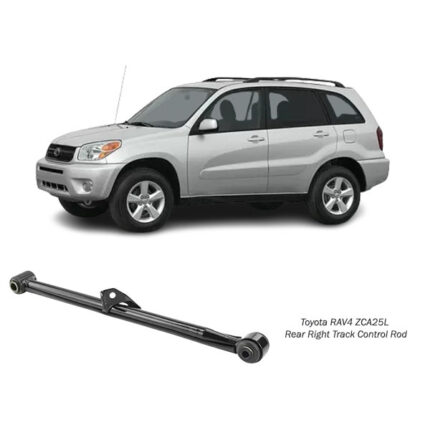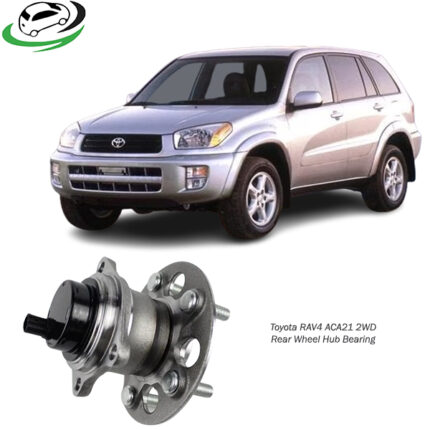-8%
Get Toyota RAV 4 ACA21 Rear Wheel Hub Bearing 42410-42020 in Kenya
When it comes to motion, balance, and control, there’s a hidden component working silently behind the scenes to keep things running seamlessly—the rear wheel hub bearing. 🛞
You may not see it, hear it (unless something’s wrong!), or even think about it—but this tiny powerhouse plays a HUGE role in making sure every journey is smooth, steady, and safe. Let’s dive deep into what it does, why it matters, and when it needs attention. 🧐
🌀 What Is a Rear Wheel Hub Bearing?
At its core, a rear wheel hub bearing is a set of steel balls or rollers tightly enclosed in a metal ring (called a race). It’s part of the hub assembly, which connects to the wheel and allows it to rotate freely with minimal friction. Think of it as the quiet bodyguard keeping motion steady and smooth. 🤝
This small but mighty part is built to take on weight, road force, heat, and vibration—all at once. It also plays a vital role in keeping everything aligned so that everything turns just as it should. 🎯
⚙️ What Does It Actually Do?
You might be surprised just how much work this little unit does. Here’s what it’s responsible for:
✅ Reduces Friction – So motion stays fluid and efficient
✅ Supports Weight – Helps carry the load evenly across all moving parts
✅ Ensures Stability – Keeps everything tight and balanced
✅ Smooth Rotation – Ensures smooth turning and rolling without wobble
✅ Protects Other Components – Prevents wear and tear on surrounding parts
It’s truly the backbone of motion, holding things down while allowing everything else to move freely. 🧠💪
🛑 Signs That a Rear Wheel Hub Bearing Might Be Failing
Even the best-built bearings have their limits. Over time, they can wear down—especially if exposed to dirt, moisture, or extreme stress. Here are some telltale signs that a rear hub bearing may be reaching the end of its life:
🔊 Unusual Noises – Growling, humming, or grinding sounds that increase with speed
🌀 Wobble or Vibration – A shaky or loose feeling during motion
💨 Dragging or Resistance – When movement doesn’t feel as free or effortless
⚠️ Uneven Rotation – You may feel jerky or inconsistent movement
🌡️ Overheating – Excess heat around the area due to increased friction
If you’re feeling or hearing any of the above, it’s your system’s way of saying, “Hey, check me out!” 👂👀
🔍 What Causes Rear Wheel Hub Bearings to Wear Out?
Let’s be real—no part lasts forever. But knowing what leads to wear and tear can help extend its life. Here’s what typically causes issues:
🌧️ Water/Dirt Ingress – Moisture and debris can sneak past seals and cause corrosion
🚧 Rough Conditions – Constant bumps, potholes, or off-road use can stress the bearing
🧊 Extreme Temperatures – Sudden changes can shrink or expand components, affecting fit
📦 Overloading – Carrying more weight than intended puts extra strain on the system
❌ Improper Installation – A misaligned or poorly installed bearing won’t last long
🛠️ Neglected Maintenance – Lack of inspections can let small issues grow into big ones
Avoiding these can greatly increase the lifespan of your bearing—and the comfort of your experience. 💯
🔁 Replacement: When and Why?
So, how long do these bearings last? Generally, they’re built to go the distance—anywhere from 80,000 to 150,000 km, depending on conditions and quality. However, once they start to fail, it’s crucial to replace them ASAP. 🚨
Here’s why:
⚙️ A worn bearing can affect balance, leading to faster wear on other components
🧲 In some cases, it can cause uneven movement, creating safety risks
🔩 It can even damage the surrounding assembly if ignored for too long
Replacement involves removing the hub assembly and pressing in a new bearing. It’s a precision job that should be done right to ensure long-term performance. 🛠️🧰
✅ Benefits of a Healthy Rear Wheel Hub Bearing
Let’s not forget the why behind all of this. Keeping your bearing in top shape delivers serious benefits:
🛞 Smooth, Silent Motion – No grinding, humming, or drag
📐 Better Alignment – Everything stays straight and steady
🛡️ Longer Component Life – Less wear means fewer repairs
🔒 Increased Safety – Prevents breakdowns or dangerous wobble
🚀 Improved Performance – Everything runs more efficiently and effectively
Simply put, it makes your entire motion system stronger, smarter, and more reliable. 💪🔥
🧠 Pro Tips for Bearing Care
Want to maximize the life of your rear hub bearing? Follow these pro tips:
🔍 Inspect regularly – Catch small issues before they turn big
🧼 Keep things clean – Protect from mud, water, and dust
🚫 Don’t overload – Stick to your system’s designed weight limits
🛠️ Use quality parts – Cheap bearings wear out faster and fail sooner
🔧 Install professionally – Precision matters—trust the experts
Preventative care is always cheaper (and easier) than emergency repairs. 👨🔧✅
🎯 Final Thoughts
The rear wheel hub bearing may not be flashy or talked about much—but it’s absolutely essential. It’s the quiet champion of stability, motion, and control. Whether you’re gliding along smoothly or hearing odd noises during movement, never underestimate what this tiny component is doing behind the scenes. 🎩🛞
When it’s good, you barely know it’s there.
When it’s bad, everything else suffers.
So next time you think about smooth motion, balance, or that satisfying glide, give a silent nod to the humble but mighty rear wheel hub bearing.
Follow us on Facebook for more parts.



